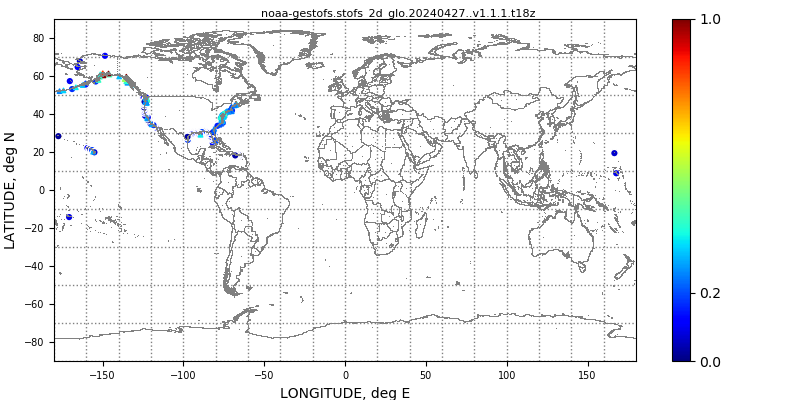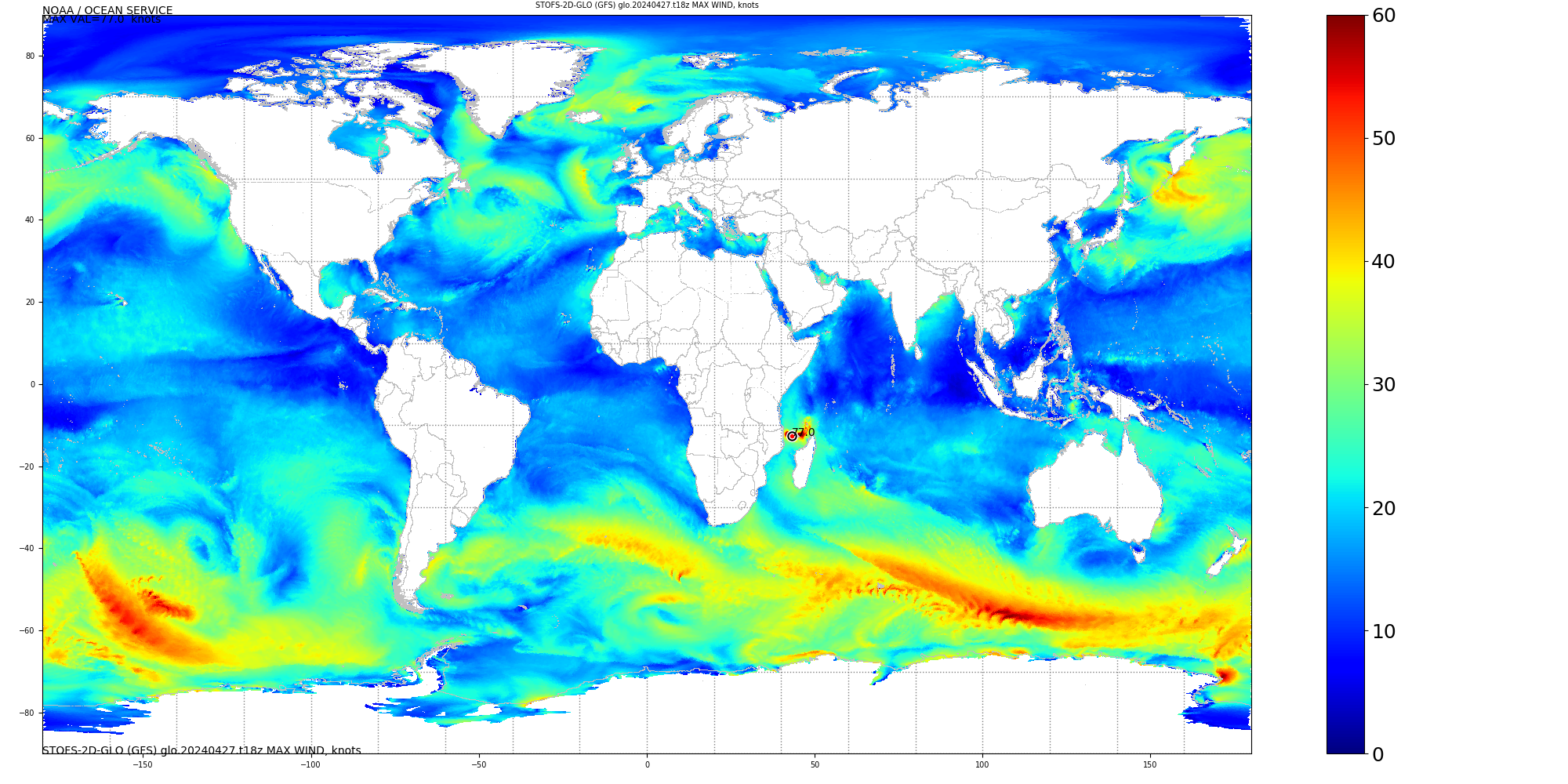This is an experimental web portal for graphic visualization of the operational and experimental results from the storm surge and tide forecast systems being developed and tested by the National Ocean Service.
STOFS model output is NOT total water level guidance. Actual water levels can be significantly higher than forecast due to waves and other components not presently included in STOFS.
Please check with your regional National Weather Service forecast office for the official water level forecast.
This page provides experimental web dissemination for the output and validation of the Global Surge and Tide Operational Forecast System 2-D (STOFS-2D-Global).
The Coastal & Marine Modeling Branch (CMMB) of the Coast Survey Development Laboratory (CSDL) has upgraded STOFS-2D-Global to v2.1. This STOFS-2D-Global upgrade:
*includes bias correction at station locations where NOS/CO-OPS observations are available. This bias correction a) computes the bias at these stations by subtracting the combined (storm surge + tide) water level forecast guidance from the observed water level, b) removes this hourly bias from the current cycle’s 6-hour nowcast, c) averages the bias over 5 days using the most recent 5 days of nowcasts and observations, and d) removes this average bias from the future forecast guidance (with a 12-hour linear interpolation from current bias to average bias). This post-processing bias correction is implemented in STOFS-2D-Global in the same way that Extra-Tropical Storm Surge (ETSS) implements it (also called “anomaly”, which is the same as the negative bias). Note that no gridded bias correction is implemented in this version of STOFS-2D-Global.
*improves temporal resolution for GFS forcing, by including hourly GFS forcing out to 5 days in the forecast, then 3-hourly from 5 days to 7.5 days in the forecast. Previously, 3-hourly GFS forcing was used for the entire forecast period.
*improves coastal topography, bathymetry, friction values, and the mesh, for improved accuracy of water level forecast guidance. Specifically, there are improvements to the bottom boundary conditions (friction, topography, and bathymetry), and a few mesh nodes were adjusted for improvement in performance. Also, a model output station was added at a relatively new tide gauge at NOS/CO-OPS Bremerton, WA (9445958).
The user evaluation and feedback for STOFS-2D-Global was officially collected up until September 25 2023, but we will always welcome feedback. The STOFS-2D-Global Upgrade Briefing to the NCEP Director occurred on September 29 2023. Operational implementation of the STOFS-2D-Global upgrade to v2.1 occurred at the 12 UTC cycle on May 14 2024.
Evaluation is always being sought to verify that the upgrade of STOFS-2D-Global to v2.1 improves or maintains skill in the forecast guidance it provides for your use.
Please send your feedback to:
Greg Seroka [email]
Edward Myers [email]
Saeed Moghimi [email]
Model: ADCIRC v55, 2D depth-integrated, with internal tides, self-attraction & loading. Spherical coordinates on an unstructured global mesh
Forcing: GFS-FV3 13km 10-m winds, mslp, seaice, tidal potential with short-period 13 harmonics
Mesh: Global. Node count: 12,785,004. Elements count: 24,875,336. Coastal resolution: at least 1.5 km globally. Nominal coastal resolution (US): 120m. Maximal coastal resolution: 80m (30m Chetco River, OR). Open ocean resolution: 40km. Upland boundary: +10m MSL along the US East Coast, up to 20m for some of the US Pacific Islands. Flood plain spatial resolution: nominal 500m for the US East Coast, up to 80m for some of the US Islands.
Computation: Computational time step: 6 seconds (implicit). In total, STOFS-2D-Global currently runs on 3,968 computational cores on Weather and Climate Operational Supercomputing System 2 (WCOSS2).
Maximal forecasted water level elevation (maxele) on a native netCDF, 6-min forecast water level timeseries at 1688 point locations worldwide, hourly snapshot fields in GRIB2 format on NDFD subgrids (CONUS, North Pacific, Alaska, Hawaii, Guam, Puerto Rico).
Digital Output: netCDF and GRIB2 output is available via https://nomads.ncep.noaa.gov/pub/data/nccf/com/stofs/prod/.
Graphics Output: this page provides links to reports including map plots of the maximal forecasted water level elevation (maxele), map plots of the maximal forecasted GFS winds, timeseries plots of the forecasted combined water levels along with the observed water levels where available, average and individual skill metrics for the point outputs where the observations are available. The reports are generated for operational STOFS-2D-Global.
The typical auto-generated model report provides the following information:
Name (tag) of the experiment. The tag includes datestamp of the forecast cycle. It is printed on each plot. Please verify that you are looking at the latest cycle by checking the tag.
Datestamp when the report was generated (UTC)
Date span for the statistical analysis (UTC)
Bounding box of the geographical coordinates (East longitudes/North latitudes)
The section Maximal Forecasted Water Levels containing the maps of maxele fields for the whole domain and key sub-domains.
The section Time-Series Metrics containing the output and the analysis of the water level point output.
Skill metrics is reported for the time series comparison of the point output against NOAA coastal tide gauges water level observations, where available.
Metrics includes:
| Skill (units) |
Description |
Best Skill Value |
| RMSE (meters) | Root Mean Square Error between the model and the observations. | RMSE=0 |
| PEAK (meters) | Under/overestimation of the maximal water level. | PEAK=0 |
| PLAG (minutes) | Time lag between the modeled and the observed peak in water level. | PLAG=0 |
| BIAS (meters) | Linear bias in the modeled water level. | BIAS=0 |
| VEXP (%) | Variance explained, a measure of a coherence between the model and the observations. | VEXP=100 |
| SKIL (unitless) | Statistical Skill of the model against the observations. | SKIL=1 |
| RVAL (unitless) | R-Value of the model against the observations. | RVAL=1 |
| NPTS (unitless) | The number of 6-minute model/data pairs at the location that went into computing the above metrics. |
Metrics is computed for each individual point output station. All point output is provided in the Individual Time-Series Statistics sub-section of the report.
Below is the example of the time series analysis for a given station, showing the modeled (blue) and observed (green) hydrographs, and the corresponding metrics:

Individual station analysis provides time series skill for the model on the date span where the results overlap the observations. On the example above, the statistics were computed over the 17.8 hours (178 6-minute points where both model and data are valid). Skill metrics is represented as both a text table and a dashboard, with acceptable ranges for each skill shown in green bars.
The maps for each skill metrics of all valid individual stations are provided in the experiment report in the Average Time-Series Statistics sub-section of the report.
The example below shows the map of RMSE values at each valid station. Values below a 0.2m threshold are plotted as circles. Values above 0.2m are plotted as upward-looking triangles, to help identify areas where the error is larger than a given threshold.

Stations without the observations only report modeled nowcast/forecast time series (blue curve).
Average skill metrics for the experiment is shown in the table in the Average Time-Series Statistics sub-section of the report.
STOFS Pre- and Post-Processing Software
The pre- and post-processing software including skill computations has been developed by CSDL, in collaboration with other partners. The codes are written in Python3, and are publicly available from GitHub.
The baseline library csdllib.
The automated skill analysis application autoval.
| STOFS-2D-Global |
[Report] operational |
|
| ESTOFS-ATL |
[Report] decommissioned 24 Nov 2020 |
|
| ESTOFS-PAC |
[Report] decommissioned 24 Nov 2020 |
|
| ESTOFS-MIC |
[Report] decommissioned 24 Nov 2020 |
Maximal forecasted GFS winds for the latest operational STOFS-2D-Global cycle (in knots):

